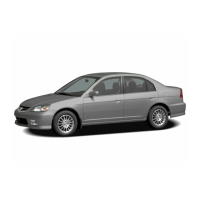
Do you have a question about the Acura EL 2005 and is the answer not in the manual?
| Brand | Acura |
|---|---|
| Model | EL 2005 |
| Category | Automobile |
| Language | English |
Instructions for safe seating, seat belts, and airbag awareness for adults and teens.
Detailed information on seat belt system components, operation, and maintenance.
Explanation of front and side airbag systems, including their operation and safety.
General guidelines and specific information for restraining infants and children safely.
Advice on choosing the correct child seat type and features for safe installation.
Guidance on seat belt fit, booster seats, and safety for older children.
Overview of control locations within the vehicle's cabin for easy access.
Explanation of the vehicle's dashboard layout and indicators.
Details controls located on or around the steering wheel.
Procedures for adjusting the steering wheel for optimal driving position.
Information on vehicle keys, locks, and their operation.
Explains the vehicle's anti-theft immobilizer system and its function.
Details on the different positions of the ignition switch and their functions.
Operation of the vehicle's door locking mechanisms.
Information on opening and closing the vehicle's trunk.
Operation of the vehicle's remote keyless entry transmitter.
Guide to adjusting the front seats for comfort and safety.
Information on adjusting head restraints for occupant safety.
Overview of the vehicle's comfort and convenience features.
Explains the function of various air flow control buttons.
Factors affecting radio signal quality and reception.
Operating the optional multi-disc CD changer.
Tips for handling and cleaning CDs to prevent damage.
Troubleshooting common error messages from the CD player.
Troubleshooting common error messages from the CD changer.
Maintenance tips for the tape player and cassette tapes.
Adjusting the set speed for the cruise control system.
Methods to disengage the cruise control system.
How to reactivate cruise control at a previously set speed.
Recommendations for the initial driving period to ensure vehicle longevity.
Guidance on selecting the correct type and octane of gasoline.
Step-by-step instructions for refueling the vehicle's fuel tank.
How to safely open and close the vehicle's hood.
Procedures for checking the engine oil level.
How to check the engine coolant level.
Tips and practices to maximize fuel efficiency.
Important information regarding vehicle accessories and modifications.
Warnings and considerations about altering the vehicle's structure or components.
Guidelines for safely storing and transporting items in the vehicle.
Information on the vehicle's maximum load capacity.
Daily checks and adjustments to perform before driving the vehicle.
Procedures for starting the vehicle's engine under various conditions.
How to operate the manual transmission and shift gears.
How to operate the automatic transmission and select gears.
Parking procedures for automatic transmission vehicles.
Explanation of the vehicle's braking system components and operation.
How the ABS system works and its indicators.
Information regarding the vehicle's towing capabilities and limitations.
Essential safety precautions to follow during vehicle maintenance.
Recommended service intervals for regular vehicle upkeep.
Specific maintenance considerations for Canadian owners.
Information on dealer service and DIY maintenance options.
List of items to check regularly for vehicle upkeep.
Revised maintenance schedule for vehicles used in demanding conditions.
Log for recording vehicle maintenance performed under severe conditions.
Diagram showing the location of all vehicle fluid reservoirs and dipsticks.
How to add engine coolant to the reserve tank.
Steps for checking, adding, and changing engine oil and filter.
Information on engine coolant types and levels.
Checking engine coolant and refilling windshield washer fluid.
Checking clutch fluid and power steering fluid levels.
Information on timing belt replacement and checking brake fluid.
Checks and considerations for the clutch system.
How to check and add power steering fluid.
Maintenance for the hood latch and replacement of headlight bulbs.
Instructions for replacing front turn signal and fog light bulbs.
Care for floor mats, replacing the dust/pollen filter, and wiper blades.
Importance of proper tire inflation for handling and wear.
Recommended cold tire pressures for normal and high-speed driving.
Maintaining tires through alignment and balancing.
How and when to rotate tires for even wear.
How to inspect tires for damage, wear, and proper inflation.
Guidelines for replacing vehicle tires and wheels.
Advice for driving in winter conditions, including tire choice.
When and how to use snow tires for better winter traction.
Guidelines for using tire chains on the vehicle.
Information and precautions for using the compact spare tire.
Step-by-step instructions for changing a flat tire.
Troubleshooting common causes for an engine that fails to start.
Procedures and safety precautions for jump starting a dead battery.
Steps to take if the vehicle's engine overheats.
What to do if the low oil pressure warning light illuminates.
What to do if the charging system warning light indicates a problem.
Explanation of the check engine light and its potential causes.
Information on vehicle readiness codes for emissions testing.
What the brake system warning light signifies and how to respond.
Manual procedure to close the moonroof if the electric motor fails.
How to check and replace vehicle fuses.
Guidelines and methods for safely towing a disabled vehicle.
Location of VIN, engine, and transmission identification numbers.
Key dimensions, capacities, and engine specifications for the vehicle.
Explanation of the U.S. DOT tire grading system.
Understanding the markings and information on tire sidewalls.
Explanation of tire treadwear, traction, and temperature ratings.
Overview of the vehicle's emission control systems.
Details on PGM-FI, ignition timing, EGR, and catalytic converter systems.
Operation and maintenance of the catalytic converter.
Requirements and procedures for provincial emissions testing.
How to ensure readiness codes are set for emissions tests.
Contact information and procedures for customer service.
Overview of the vehicle's warranty coverage details.
Recommended gasoline type and octane rating.
Recommended engine oil type and viscosity.
Recommended ATF type and capacity.
Recommended MTF type and capacity.
Recommended power steering fluid type.
Recommended brake fluid type.
